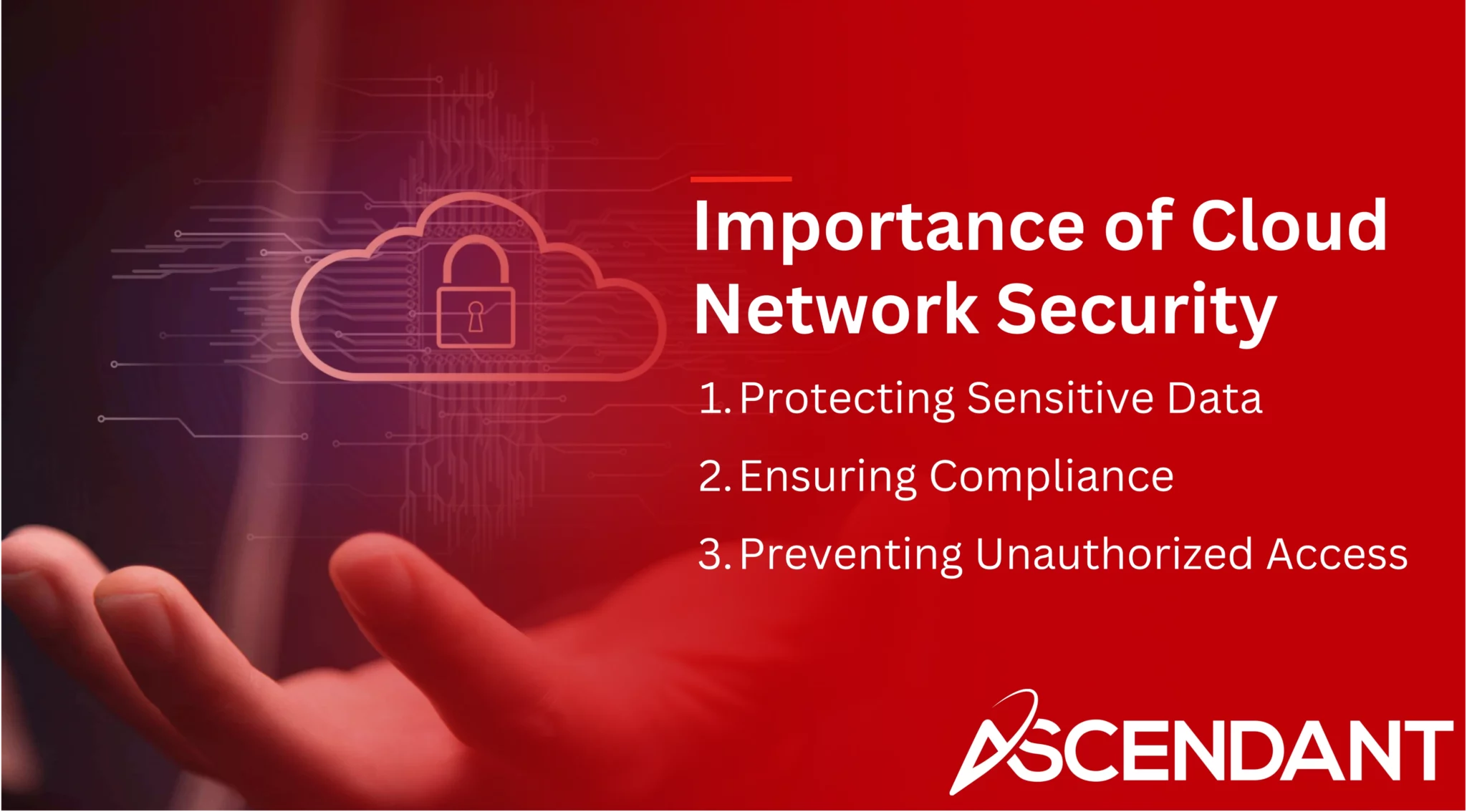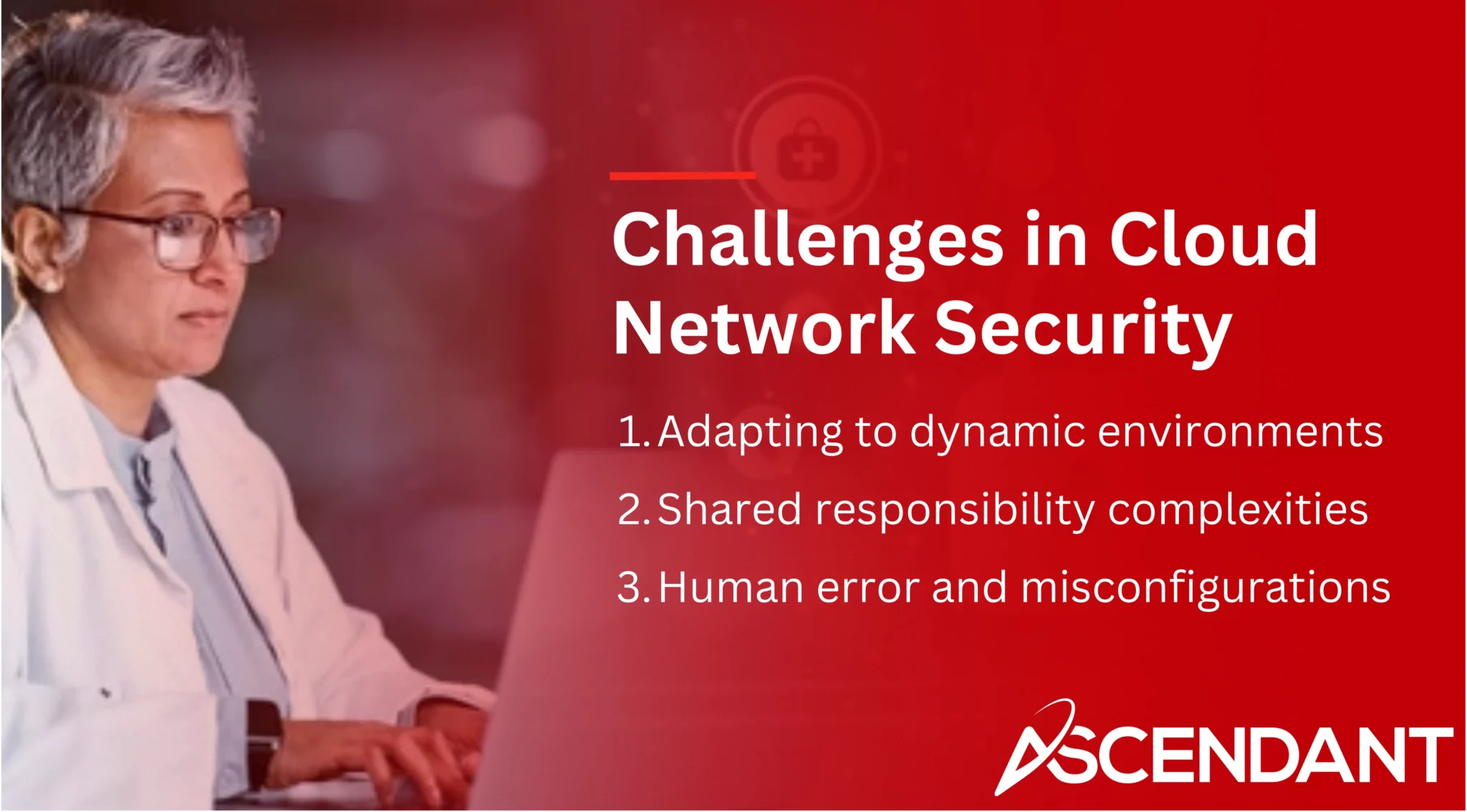Cloud network security protects your data, applications, and systems in the cloud. It’s crucial for preventing unauthorized access, ensuring compliance, and maintaining the integrity of your operations. This article provides an overview of key practices, benefits, and challenges in cloud network security.
Key Takeaways
- Cloud network security is critical for protecting data and applications, defined by a shared responsibility model between cloud service providers and users.
- Key elements include next-generation firewalls, intrusion prevention systems, and centralized monitoring tools to enhance data protection and compliance.
- Implementing best practices like zero trust principles, encryption, and continuous monitoring, alongside leveraging AI for threat detection, is essential for robust cloud security.
Understanding Cloud Network Security
Network security in the cloud involves an array of strategies such as procedures, practices, safeguards, and solutions that are put into place to defend cloud networks. This is vital for companies as it protects their information and systems hosted on the cloud and diminishes potential security threats.
A crucial component of securing a network within the cloud entails protecting applications, data, and devices linked to the cloud from external dangers. Nevertheless, applying these protective measures can present difficulties. This holds especially true when overseeing both pure and hybrid network models which lack a conventional network perimeter.
The basics of cloud computing
Cloud computing provides resources like storage, applications, and computational power over the internet. Within this framework, cloud service providers (CSPs) are tasked with safeguarding the foundational infrastructure and fortifying their servers against threats. Simultaneously, users must protect their own data and application security. This distribution of duties is encapsulated in what’s known as the shared responsibility model—essential for mitigating risks and bolstering security within cloud environments.
Understanding this concept of shared responsibility is vital to developing a robust cloud security strategy. By acknowledging the joint roles played by both cloud providers and users in maintaining secure systems, organizations can deploy more comprehensive security measures that effectively minimize vulnerabilities.
Key elements of cloud network security
Essential components for securing the cloud network encompass state-of-the-art firewalls, antivirus programs, tools to thwart bots, systems to prevent intrusions, Identity and Access Management (IAM), along with measures against data loss. These elements are tailored to integrate smoothly into cloud environments and enhance the capability of security teams by offering enhanced visibility as well as instantaneous monitoring of network activities. Features like service mesh contribute additional protection through mutual TLS implementation, refined access controls and encryption protocols applied to traffic.
Contemporary network security solutions created for the cloud yield immediate notifications and detailed audit trails which empower security teams in upholding a secure stance within their respective cloud architectures. Advanced protective features available from resources such as Prisma Cloud or ingress controllers help fend off external HTTP-based incursions among other threats through scrutinizing incoming traffic policies coupled with terminating TLS connections thereby shielding applications hosted in the cloud.
Access control mechanisms specifically devised for remote connectivity ensure that distant employees and third-party affiliates gain safe entry while keeping unauthorized personnel away from pivotal assets stored on clouds. The deployment of automated systems aimed at vigilant monitoring paired with efficient threat identification is crucial in exerting governance over all networking flows hence diminishing chances associated with misconfiguration errors. Collectively these precautions establish a robust framework indicative of an effective strategy dedicated to bolstering overall safety across various segments constituting our modern-day utilization of technology housed within the ethers called “cloud”.
Importance of Cloud Network Security
Ensuring the security of cloud networks is crucial for the protection of data, applications, and infrastructure within various cloud environments. The establishment of robust security measures bolsters data safety and minimizes potential exposure to cyber threats. By amalgamating technology with policies and procedures, entities can defend their cloud environments against illicit entry while maintaining the steadfastness of their business activities.
Insecure cloud systems that experience data breaches may face profound consequences due to heightened susceptibility to cyber-attacks, which makes them appealing targets for malicious actors. Not only do rigorous security measures in a cloud network reinforce an organization’s adaptability and its ability to react swiftly to shifts in the marketplace, but they also facilitate considerable savings on IT expenditures by optimizing costs and elevating service standards.
Protecting sensitive data
Securing cloud environments is critical to avoid legal consequences and shield confidential information from exposure. The principal benefit of network security in the cloud includes bolstering protection for this sensitive data. To defend data within these cloud networks, strategies such as encryption and micro-segmentation are crucial because they minimize the impact of breaches by keeping data undecipherable to those without permission.
Centralized management systems enhance the application of uniform security policies across hybrid and multicloud infrastructures, simplifying supervision over security protocols. By uniformly implementing these measures, organizations can sustain a strong defense against threats and ensure their essential cloud assets remain safeguarded.
Ensuring compliance
Adhering to regulatory compliance is essential not only for circumventing legal complications, but also for safeguarding sensitive data. A compromised security infrastructure can lead to substantial legal repercussions and erode the trust of shareholders. The continuous monitoring afforded by Cloud Security Posture Management (CSPM) tools plays a pivotal role in maintaining consistent regulatory conformity.
The concept of shared responsibility model underlines that securing network infrastructures is a collaborative endeavor involving both the customer and their chosen cloud provider. Any misinterpretations regarding who holds what security responsibilities could potentially result in weaknesses within the system’s defense, thereby underscoring the necessity for clear communication and strict adherence to policies.
Enhancements like encryption strategies and micro-segmentation are instrumental in bolstering compliance efforts as they encapsulate critical systems, thus curtailing prospective vulnerabilities by minimizing exposure points susceptible to attacks.
Preventing unauthorized access
The practice of role-based access control (RBAC) plays a crucial role in safeguarding against unauthorized access by allotting permissions according to the roles users play. By doing so, it confines the scope of damage that can result from a security breach by ensuring only necessary personnel have access privileges. Segregating containers not related to each other with network policies enhances protection by obstructing unwanted traversals between pods if an intrusion occurs.
To diminish risks within cloud environments, Cloud Infrastructure Entitlement Management (CIEM) enforces strict guidelines for user access to specific cloud resources—charging those utilizing cloud infrastructure with tasks such as securing applications and data governance, managing who is granted entry rights, and vigilance over potential external threats.
Given that human error frequently contributes to security vulnerabilities within cloud environments, there’s a heightened necessity for stringent access control measures paired with relentless monitoring practices. Integrating data encryption fortifies these defenses by obfuscating any compromised information from being decipherable by malicious entities.
Benefits of Cloud Network Security
The implementation of cloud network security brings with it a range of advantages, such as fortified defenses owing to potent systems and the heightened ability to detect potential threats. By enabling centralized oversight and control, this model is essential for managing the expansive nature and streamlined functionality that characterize cloud infrastructures. Employing rigorous best practices in cloud network security can also culminate in financial savings by reducing incidents of compromise and optimizing resource allocation.
Artificial intelligence (AI) and machine learning are instrumental in bolstering cloud security by employing forward-looking approaches that scrutinize data for emerging risks. These cutting-edge technologies empower organizations to preventively address hazards, thereby maintaining a robust defense against potential vulnerabilities.
Enhanced protection and threat detection
The latest advancements in cloud security tools are tailored to seamlessly work with SaaS applications and the broader cloud infrastructure. Their aim is to deliver comprehensive defense against both recognized threats and those not yet identified. Among these solutions are systems for detecting intrusions, scanners designed to identify bot activity, and cutting-edge prevention technologies that employ threat intelligence for pinpoint detection of evolving dangers.
For combatting established vulnerabilities as well as zero-day exploits, it’s essential to deploy a layered approach to threat management. The incorporation of both CPU and GPU technologies into the fabric of cloud network security significantly accelerates the process of threat identification and response. This ensures that malevolent actors or software are swiftly uncovered, isolated from critical systems, and rendered harmless with efficiency.
Scalability and flexibility
The necessity to scale network security is crucial in cloud environments, where there’s an increasing need for resources and services. Companies require scalable security tools that enable expansion without overwhelming their teams, which helps preserve nimbleness and quick reaction times within the ever-evolving cloud network.
In multi-cloud and hybrid environments, having adaptable security measures becomes increasingly important for maintaining efficient operations while upholding strong protection. These highly scalable networks benefit from flexible security practices capable of adjusting to evolving needs—ensuring uninterrupted business performance with assured robust safety protocols.
Cost efficiency
By diminishing the likelihood of data breaches, cloud network security plays a crucial role in lessening the economic repercussions associated with security incidents. Organizations that adopt cloud-based networks can notably enhance their cost-effectiveness due to increased protection against financial losses resulting from compromised data integrity.
Simplified management
Security administration is made more efficient in diverse cloud environments through the use of centralized management tools, which aid security teams in upholding robust protection measures. An integrated management platform facilitates easier control over complex multi-cloud and hybrid environments by offering extensive insights with thorough logs and reports.
Cloud security mechanisms are instrumental for prompt incident response and forensic investigations as they provide essential visibility into system operations. This streamlined approach to managing workflows augments the potency of cloud security solutions by simplifying how organizations detect and resolve security vulnerabilities.
Challenges in Cloud Network Security
Migrating to cloud environments presents new challenges for identifying and countering security threats, diverging from conventional methods. As the well-defined perimeter that was once easy to secure becomes more elusive within a cloud infrastructure, it necessitates that organizations revamp their strategies concerning network security protocols. Cloud networks are commonly threatened by exploitation of software vulnerabilities, DDoS attacks, poorly secured APIs, and illicit access.
Should a breach occur in the realm of cloud security, an organization could suffer substantial financial setbacks as well as drain on time and operational capacity. While centralized control over monitoring can increase oversight over various activities within these expansive cloud landscapes. Yet there is an ongoing hurdle faced by security teams in sustaining vigilance and overseeing user behavior systematically.
Embarking on measures to enforce robust cloud security is fraught with additional complexities which add layers of difficulty for enterprises attempting such initiatives.
Adapting to dynamic environments
Ensuring security within ever-evolving cloud environments presents a significant challenge. The incorporation of automation functions, such as autoscaling, adds layers of complexity to the management of security in a cloud environment. This necessitates that administrators vigilantly monitor access requests, act upon alerts promptly, and identify potential threats to maintain the integrity of cloud network security.
It is imperative for organizations to stay alert and flexible, consistently refining their security protocols in alignment with the fluid landscape of cloud environments. Such agility is essential for sustaining secure cloud environments and safeguarding vital resources against new and developing threats.
Shared responsibility complexities
Confusion over the delineation of security duties can result in substantial vulnerabilities within cloud security. Blending on-premises infrastructures with a mixture of public and private cloud deployments complicates discerning who is responsible for what aspects of security. It’s imperative to understand the shared responsibility model as it crucially distinguishes the roles between users and cloud service providers regarding safety protocols.
This intricate landscape can muddy understanding, thereby exposing organizations to heightened security threats. To combat such obscurities, explicit communication along with unambiguous policies are indispensable tools that facilitate traversing these intricacies while safeguarding a secure cloud environment.
Human error and misconfigurations
The anticipated cause of 99% of cloud security breaches by the year 2025 is expected to be human error, underscoring the critical need for robust security measures and extensive training. The magnitude of potential incidents due to human error emphasizes the pressing necessity for efficient protective actions and knowledge enhancement. By automating security, organizations can significantly mitigate the risk associated with manual configurations thus curtailing chances for misconfigurations that lead to breaches.
It’s imperative that companies allocate resources towards ongoing education and skill development for their cloud security teams in an effort to curtail such errors. Employing automated cybersecurity tools provides additional fortification by ensuring uniform adherence to established security policies while also reducing reliance on direct human intervention which often leads to vulnerabilities.
Best Practices for Cloud Network Security
It is crucial to implement a thorough approach that integrates various security measures when safeguarding cloud environments. Practices for securing the cloud network consist of employing strategies and tools specific to cloud security designed to counteract malware, unauthorized access attempts, DDoS assaults, and additional internet-based dangers.
The deployment of automated security solutions in protecting against these threats can also lead to lower operational expenses by diminishing the necessity for hands-on administration and supervision.
Implement Zero Trust principles
In the zero-trust framework, security is moved away from a centralized network perimeter and toward each user and device. This model eschews granting implicit trust to users or devices. Instead, it insists on endless validation of credentials. By adopting an approach that denies access by default, one can augment security through strict regulation of permissions.
Critical strategies like role-based access control (RBAC), multifactor authentication (MFA), virtual private networks (VPNs), and firewalls are instrumental in thwarting unauthorized entry within multi-cloud environments. Partitioning these cloud landscapes curtails lateral traffic—east-west movement—which in turn bolsters overall cybersecurity resilience.
Secure internet-facing services
It is imperative to safeguard services exposed to the internet, as they are susceptible to potential threats and various attacks. Defensive measures like Web Application Firewalls (WAF) and mechanisms against DDoS assaults secure weak spots within cloud applications. WAFs play an essential role in shielding from dangers at the application layer, including SQL injection hazards.
Adopting strategies for DDoS defense coupled with continuous monitoring fortifies the security posture of services facing the internet by enabling prompt detection and resolution of possible threats.
Use micro-segmentation
In cloud environments, micro-segmentation serves as a strategy to segregate sensitive information, offering augmented security by restricting the horizontal transfer and managing application traffic. By detaching private data from the broader cloud network using micro-segmentation, it substantially reduces potential exposure to illicit entry and compromises in data integrity.
Encrypt sensitive data
Encryption is essential for ensuring that data remains secure both at rest and during transmission within cloud infrastructures. Cloud providers offer various encryption services that enable organizations to secure their sensitive data effectively. Using encryption not only safeguards data from potential breaches, but also enhances compliance with data protection regulations.
Strong encryption practices help organizations protect data critical data assets and ensure that intercepted data remains unreadable to unauthorized users.
Continuous monitoring and automated responses
Continuous monitoring of network traffic is crucial for promptly identifying and addressing security breaches, such as illicit access attempts or data leaks. Tools designed for continuous surveillance offer instant notifications and automatic countermeasures against such incidents, guaranteeing a swift reaction.
By integrating automation within access controls, threat identification capabilities are bolstered significantly in terms of efficiency, mitigating the likelihood of mistakes due to human oversight while ensuring command over network movement. Machine learning technologies enable ongoing real-time observation that swiftly adapts to new security challenges—an essential adaptation aligned with contemporary DevOps’ rapid pace.
Role of AI and Machine Learning in Cloud Network Security
By utilizing machine learning, AI strengthens security within the cloud network by proactively recognizing and addressing threats. It conducts immediate analysis of user activities to uncover irregularities and possible dangers, subsequently bolstering the measures taken for cloud security. Machine learning scrutinizes extensive data quantities, refining security operations while boosting efficiency across the board.
Nevertheless, an excessive dependence on AI might give rise to intricate risks like Advanced Persistent Threats (APTs) that can fabricate misleading profiles. Tools such as Content Disarm & Reconstruction (CDR), which are automated response systems, play a pivotal role in enhancing cloud network protection by swiftly identifying and countering threats to maintain robust security protocols.
Behavioral analysis for threat detection
AI-driven behavioral analysis is adept at spotting potential threats through the scrutiny of user behaviors and pinpointing deviations from the norm. With an impressive detection rate of 99.8%, Check Point’s AI-based threat prevention system showcases its high efficacy in recognizing dangers, illustrating the growing reliance on artificial intelligence to bolster threat identification within cloud environments.
By perpetually tracking both user conduct and network traffic, AI ensures that any early signs of possible security issues are promptly identified, thus allowing security teams to react swiftly and decisively when faced with such incidents.
Automated threat response
Continuous monitoring in a cloud environment plays a pivotal role in the immediate identification of anomalies and potential threats, which is crucial for triggering automated responses that mitigate risks. This constant vigilance enhances the security posture by ensuring rapid and effective handling of any security incidents within the cloud network.
Leveraging AI and machine learning technologies to scrutinize data patterns and user behaviors markedly bolsters threat detection accuracy, thus facilitating an automated response system. Such integration proves indispensable for fast and efficient counteraction against emerging threats, solidifying the integrity of a secure cloud infrastructure.
Choosing the Right Cloud Network Security Solution
When selecting an appropriate cloud network security solution, it is crucial to assess the security capabilities offered and determine how well these solutions can be incorporated into current systems. The integration of cloud-based security measures with on-premises solutions can significantly bolster a company’s total network defense.
Organizations may also opt for managed services to handle their cloud network security needs, which transfers the responsibility of managing certain tasks and associated risks over to external providers. This enables businesses to devote more attention to their primary operational activities.
Evaluating security features
Security teams must ensure that cloud network security solutions are equipped with real-time threat protection capable of combating both identified and emerging vulnerabilities. It is essential that next-generation firewalls incorporate advanced traffic analysis and sophisticated filtering capabilities, surpassing basic whitelisting methods.
It is critical for the chosen solution to facilitate extensive oversight via user-friendly dashboards and detailed logs, which empower security teams to observe and react promptly to potential threats. Assessing these functionalities thoroughly is vital for achieving robust defense within cloud environments.
Considering integration with existing systems
To guarantee uninterrupted security management, it is imperative that cloud security solutions are versatile enough to operate across different platforms and operating systems. The integration of these solutions with Infrastructure as Code is crucial, as it facilitates their incorporation into existing setups, thus enhancing the efficiency of operations and oversight.
It’s essential for enterprises to focus on selecting cloud security options that can seamlessly meld with their present network infrastructure and hybrid environments. This ensures that a robust level of protection extends throughout all operational platforms.
Summary
In summary, securing the cloud environment is essential for organizations utilizing cloud services. By grasping core principles and acknowledging their significance while applying industry best practices, companies can safeguard their sensitive data against unauthorized entry, guarantee regulatory adherence, and enhance overall protection. Incorporating AI and machine learning elevates security measures by facilitating early threat detection and enabling automatic countermeasures. Opting for an apt security solution is crucial in upholding a robust and secure network within the cloud. Emphasizing network security in the cloud is imperative to protect your online resources effectively and ensure prosperous outcomes of your cloud deployments.
 Frequently Asked Questions
Frequently Asked Questions
What is cloud network security?
Cloud network security involves a combination of policies, processes, controls, and technologies aimed at protecting cloud networks.
Effective implementation of these measures is crucial for safeguarding data and maintaining trust in cloud services.
Why is cloud network security important?
Protecting data, applications, and systems from cyber threats is essential in cloud network security to reduce the risks and vulnerabilities associated with cloud environments.
What are some key elements of cloud network security?
A robust cloud network security framework must incorporate next-generation firewalls, intrusion prevention systems, identity and access management (IAM), data loss prevention measures, and real-time monitoring tools.
Implementing these elements is essential for protecting your cloud environment effectively.
How does AI enhance cloud network security?
AI enhances cloud network security by utilizing machine learning to proactively identify and mitigate threats, while also analyzing user behavior in real-time to detect anomalies.
This results in a more robust defense against potential security breaches.
What should organizations consider when choosing a cloud network security solution?
When choosing a cloud network security solution, it is crucial for organizations to focus on capabilities such as immediate threat detection and response, seamless integration with existing infrastructure, and offering expansive oversight via user-friendly dashboards and detailed logs.
These factors are vital for maintaining strong security defenses and facilitating efficient surveillance across the network.



